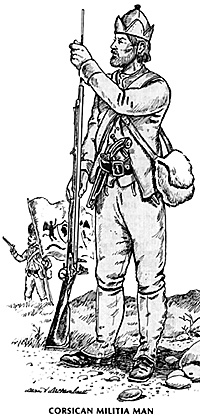 Although the Corsicans had long resented Genose
rule, a true revolt did not break out until 1729. For twenty
years the islanders fought the Genoese and their French
patrons with varying degrees of success. Finally, in 1755,
Pasquale Paoli was chosen General of the Republic. He
managed to unite the feuding Corsican clans, to drive the
Genoese back into a few coastal towns, and even to seize
the offshore island of Capraia. However, in 1768 the
despairing Genoese gave the island (of Corsica) to
France. This great power then poured in troops until, after
a fierce struggle, Paoli capitulated in 1769 -- a little before
the birth of another great Corsican named Bonaparte.
Although the Corsicans had long resented Genose
rule, a true revolt did not break out until 1729. For twenty
years the islanders fought the Genoese and their French
patrons with varying degrees of success. Finally, in 1755,
Pasquale Paoli was chosen General of the Republic. He
managed to unite the feuding Corsican clans, to drive the
Genoese back into a few coastal towns, and even to seize
the offshore island of Capraia. However, in 1768 the
despairing Genoese gave the island (of Corsica) to
France. This great power then poured in troops until, after
a fierce struggle, Paoli capitulated in 1769 -- a little before
the birth of another great Corsican named Bonaparte.
As General of the Republic, Paoli pushed through a remarkable number of military and civil reforms, so that his government caught the fancy of Enlightenment literati. Citing Sparta and Republican Rome, Paoli decried the 18th-century reliance on paid professionals. Instead he set up a national militia of all adult males. Because of the feud tradition and the country's wildness the idea worked: the army was all ready, willing, and able to use firearms.
Every local commune had its own company, averaging around 60 fighters apiece. About six companies then formed a cantonal battalion under a "commisario d'arme." These militia were nearly all infantry, although there was a small hodgepodge of cannon: Paoli thought cavalry too expensive and useless on his mountain island. In numbers the largest recorded army had four thousand men; the usual size was in the hundreds.
The Corsican national dress consisted of a short jacket and trousers of "Corsican velvet" -- a dark homespum of brown or black. Waistcoats might be of the same color or scarlet, or the jacket might be open to show only a white shirt. Two shoulder belts held cartridge and provisions pouches; a wide black waist belt was the resting place of stiletto and pistol. For headgear, the most common style was a peculiar black conical cap with red lining and four flaps. A musket, black leggings, and black shoes completed the picture.
Paoli was not wholly averse to regulars. A "volunteer company" of 100 young men was supposed to form a flying reserve. It wore the same dress as the militia, except for a distinguishing silver cross. There were two standing battalions, each with four 100 man companies: the Guards of the General and a garrison unit. The regulars wore black jackets and trousers, calf leather knee leggings, and conical boarskin caps without flaps. Officers were distinguished by lace on their collars. Finally, when the Genoese left the island in 1768, Paoli hired some German and Swiss Companies to stay behind and work for him against the French.
The most colorful man on the island was undoubtedly Paoli himself, who claimed it was necessary to dress gaudily to impress the foreigners. The General wore a green coat with green collar and cuffs; gold piping on the collar, cuffs, and lapels, and gold lace around the buttonholes; green trousers; brown waistcoat; black boots; and a black tricorn with gold tape. His horse had a red shabraque with gold edge.
For military instruments the Corsicans used Triton-shell horns. The ancient badge of the island was a white field bearing a black Moor's head with white headband. This was sometimes flown alone as a flag, but also used as a central shield in a more ornate design: gold and red crown above; alongside two black and white supporters holding clubs, who can best be described as winged satyrs; both standing on green grass; below all this a black ribbon; the entire design on a white field.
As an army, the Corsicans were well suited to mountain terrain. In addition, they proved surprisingly steadfast in holding positions or conducting sieges, probably due to Paoli's influence, which make them act more like regular light infantry than bandits (which some of them had been before). Curiously, Paoli himself was not a great general in the purely military sense. Most of the credit there belonged to his brother Clemens and other subordinates, but it was Pasquaie Paoli who gathered up the forces of the country, and breathed life into them.
SOURCES
Arrighi, Paul, compiler. Histoire de la Corse. Toulose, 1971.
Bartoli, M. Pasquale Paoli. Paris, 1974.
Boswell, James. An Account of Corsica. London, 1769.
Gregorovius, Ferdinand. Corsica. Translation, Philadelphia, 1855. Puchesse, G.B. de. "La Conquete de Corse et le Marechal de Vaux, 1769." Revue des Questions Historiques, XXVIII (1880).
Back to Table of Contents -- Courier Vol. III #1
To Courier List of Issues
To MagWeb Master Magazine List
© Copyright 1981 by The Courier Publishing Company.
This article appears in MagWeb (Magazine Web) on the Internet World Wide Web.
Other military history articles and gaming articles are available at http://www.magweb.com